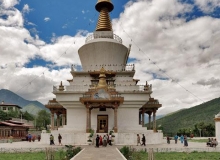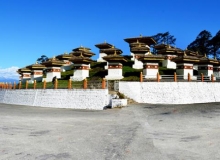
Speak to a specialist
0208 777 4873
0208 777 4873
Places to see: Bhutan

TRONGSA (2,200M)
It is the central hub of the nation and is historically the place from where attempts at unifying the country were launched. The Royal family has strong links with Trongsa. Both His Majesty King Uygen Wangchuk and his successor King Jigme Wangchuck ruled the country from this Dzong.
Trongsa Dzong: This impregnable fortress was built in 1648. The massive structure is built on many levels into the side of the hill that includes the countless courtyards, passageways and corridors in addition to the twenty-three temples inside the Dzong. Due to its highly strategic position as it the only connecting route between east and west, the Tongsa Penlop (Governor) was able to control the whole region effectively for centuries.
Trongsa Dzong: This impregnable fortress was built in 1648. The massive structure is built on many levels into the side of the hill that includes the countless courtyards, passageways and corridors in addition to the twenty-three temples inside the Dzong. Due to its highly strategic position as it the only connecting route between east and west, the Tongsa Penlop (Governor) was able to control the whole region effectively for centuries.

BUMTHANG OR JAKAR
It is situated east of Trongsa at an altitude of 2,600 m and has an individuality that charms its visitors and separates it from other regions. Comprised of four smaller valleys, the deeply spiritual region of Bumthang is shrouded in religious legend. Here tales of Guru Padmasambhava and his reincarnation known as Tertons still linger in most nooks and corners. The town of Jakar is the largest between Thimpu in the west and Trashigang in the east. Jakar is famous for honey production, cheese, apple juice and apricots. Visitors to Bumthang should plan to spend a few days taking advantage of the valley’s relatively gentle slopes to walk to nearby medieval temples and have a glimpse of Bhutan’s mostly rural population. It is also known for its woollen material (Yatra), which can be seen, hung outside of houses for sale. Further east there is the Ura valley in its centre. Small but old Dzong and cobblestone paths give the village a medieval feel. Many excursions can be arranged from this valley like Tharpaling Monastery, Kunzangdra, Tang Mebartso and many more…
Jakar Dzong: The great grandfather of Shabdrung founded it. The Dzong was initially built as a Monastery in 1549 but was upgraded after Shabdrung had firmly established his power in 1646. The Dzong is now used as the administration centre for Bumthang valley.
Jambey Lhakhang: The Tibetan King Songten Gempo built it in the 7th century. This temple is one of the 108 temples built by him to subdue a large demon, which was stopping the spread of Buddhism.
Kurje Lhakhang: It is located above Jambey Lhakhang and consists of three temples. The one on the right was built in 1652 on the rock face where the Guru mediated in the 8th century. Second temple is built on the site of a cave is not visible as it is concealed by a large statue of the Guru Rinpoche. The present Royal Queen mother recently built the third temple and these three temples are surrounded by 108-stupa wall symbolic of each joint of the Human body.
Tamshing Lhakhang: It is located opposite of Kurje Lhakhang on the other side of the river was founded in the beginning of the 16th century by Teron Pema Lingpa, the reincarnation of Guru Padmasambhava. The Monastery has very interesting religious paintings like 1,000 Buddhas and 21 Taras. The temple was restored at the end of 19th century.
Jakar Dzong: The great grandfather of Shabdrung founded it. The Dzong was initially built as a Monastery in 1549 but was upgraded after Shabdrung had firmly established his power in 1646. The Dzong is now used as the administration centre for Bumthang valley.
Jambey Lhakhang: The Tibetan King Songten Gempo built it in the 7th century. This temple is one of the 108 temples built by him to subdue a large demon, which was stopping the spread of Buddhism.
Kurje Lhakhang: It is located above Jambey Lhakhang and consists of three temples. The one on the right was built in 1652 on the rock face where the Guru mediated in the 8th century. Second temple is built on the site of a cave is not visible as it is concealed by a large statue of the Guru Rinpoche. The present Royal Queen mother recently built the third temple and these three temples are surrounded by 108-stupa wall symbolic of each joint of the Human body.
Tamshing Lhakhang: It is located opposite of Kurje Lhakhang on the other side of the river was founded in the beginning of the 16th century by Teron Pema Lingpa, the reincarnation of Guru Padmasambhava. The Monastery has very interesting religious paintings like 1,000 Buddhas and 21 Taras. The temple was restored at the end of 19th century.

PHUENTSOLING
Phuntsoling is a border town to the south bordering the Indian State of West Bengal. It is a hub of commercial activity. Jaigaon, a small Indian town is located near Phuntsoling and one can make road connections from Jaigaon or Phuntsoling to the airport in Bagdogra or the railway station in Siliguri, both in the state of West Bengal (169 kms, a drive of about 4-5 hours) of India. There are also convenient connections to Nepal, border at Kakarvitta or Indian hill stations of Kalimpong, Gangtok & Darjeeling.
Subscribe here to our monthly newsletters


